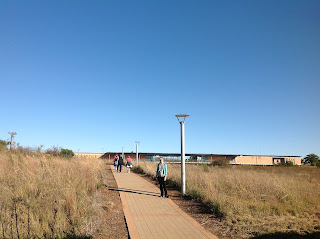You'll remember a few months ago I went down to the Eastern Cape to look at some dinosaur fossils. One of the fossils I checked out was this huge femur lying in a roadcutting, which had been pointed out to my buddy Billy de Klerk by a local farmer Mr. Selby Vorster.
Selby had, in turn, been notified of the fossil by one of his herdsmen, who accidently sat on it while eating his lunch by the side of the road (recreated discovery scene below).
It turned out that the plant Kelsey is studying, Helichrysum odoratissimum, occurs in the same area, so we decided to partner up and engage in a first-ever husband and wife field season. We were joined by (from left): Brigette Cohen (graduate student at Wits); Armstrong (preparator at Rhodes University); Leo Goosen (Education Supervisor at Rhodes); Zubair Jinnah (Lecturer at Wits); and Billy de Klerk (soon-to-be Emeritus curator at the Albany Museum and Rhodes University). Brigette took many of the great photographs below.
Since the dinosaur was on the edge of a one-lane dirt road (a numbered route down in the Eastern Cape), the local road engineers were happy to erect some signage warning farmers we were there.
This is an insanely beautiful part of the world, and apparently pretty good for trout fishing too. Forgot to pack the rod, though.
Here's the scene when we arrived:
As you can tell by Kelsey's bundling, it wasn't exactly warm. This made the fireside bar at the Mountain Shadows hotel all the more welcome every night:
Anyhow, the dinosaur was preserved in a tough sandstone, making removal a tricky process and requiring use of heavy equipment. You can always tell the rock saw is working even from a mile away because it throws a 40 foot plume of fine rock dust behind you.
Here's the progress after day one:
And after day two:
By day three we could sit in the hole we'd dug.
As we dug through the rock layers, we found some interesting stuff. We were able to tell that the fossil was a sauropodomorph dinosaur (a four legged plant eater the size of a bus) based on the size and shape of the femur and other bones, and we were also able to tell that it had been scavenged by meat eating dinosaurs because we found a bunch of their teeth in the sediments.
Leo dug out these ribs over the course of several days.
And here are some of the smaller theropod teeth I found:
Alas, the sailing couldn't remain smooth for long. Between our second and third days, somebody came by in the night and stole the exposed femur. We had to open a police docket, as such thefts are a serious crime in South Africa, but we don't have any promising leads as of yet.
Below is a composite image of the site after the theft. Individual bones are a dark color, because we've poured glue over them.
Meanwhile, Kelsey and Brigette were driving all over the backcountry, looking for plants by the side of the road.
This is the sort of area where "traffic" takes on a new meaning.
Great success!
And when we say "country roads", we mean stuff that's close to offroading. This is the road up Naude's Neck pass, see if you can spot it:
Naude's Neck is the highest pass in South Africa.
It seems no matter when you go out or where you are in South Africa, a protea will be blooming.
As if offroad conditions, cows, and fossil-stealing locals weren't enough of a hazard, the occasional "veld fire" breaks out in the dry grass of winter.
Kelsey had to drive THROUGH one of these:
Back at the dino dig, Zubair and I were able to measure a stratigraphic section
And we recruited a backhoe to do some of the heavy excavations.
The weather was moving in, and we still had miles to go, so we had the backhoe operator cover the site in loose soil to prevent any more thievery. Our net progress appeared to be zero by the time he was done.
Faced with a few afternoon hours to kill, we went to the Denorben rock art site, which is in a sandstone cave about 100 feet long and twenty feet tall. I posted on it before, but didn't have a good overview picture or any young ladies for scale.
This is the view from within the cave.
And this is the farm's outbuildings right next to the cave. Apparently bushmen used to hide stolen cattle there until it was discovered by farmers (who promptly shot the bushmen).
Our last stop was at the gallery of my friend the artist Sarah Swart (among other things, the chief South African lamp post painter to the Queen of England). She lives in the most charming sandstone house, which I showed a picture of before, but I never showed the interior.


































































.jpeg)












